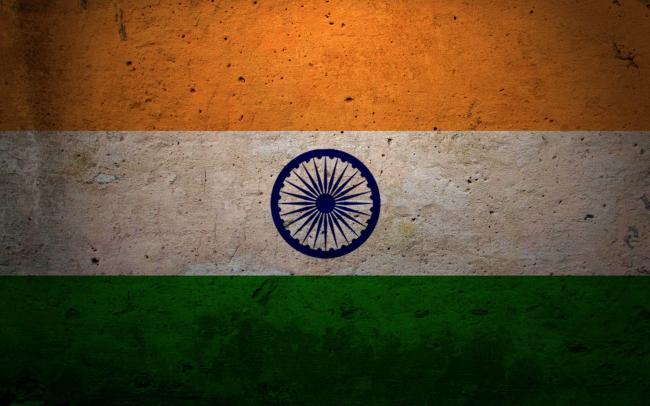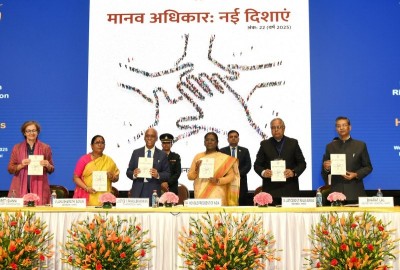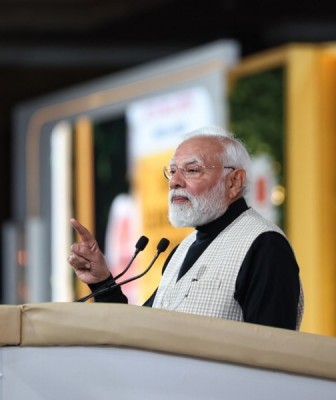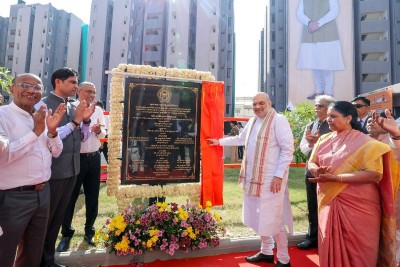
LWE: Reverses & Resistance
On March 30, 2016, seven personnel of the Central Reserve Police Force (CRPF) were killed in the Dantewada District of Chhattisgarh in a Maoist-triggered landmine explosion. The incident happened when a vehicle carrying the CRPF personnel belonging to the Ghusaras CRPF camp in Dantewada were returning after leave forHoli (the Hindu festival of colors). Three troopers were also injured in the explosion.
On March 29, 2016, three CPI-Maoist cadres were killed in an encounter with Security Force (SF) personnel in the Narayanpur District of Chhattisgarh. A statement by Inspector General of Police (IGP), Bastar Range, S. R. P. Kalluri disclosed,
At around 9.30am, when the parties were searching their target areas in Sulenga Tirkanar Forest under Dhaurai Police Station limits, the Maoists opened heavy firing on them. Our men took a position and retaliated with heavy fire and forced the Maoists to flee from the spot... Three dead bodies of uniformed Maoists were found after searching the area.
According to partial data compiled by the Institute for Conflict Management (ICM), at least 143 persons, including 42 civilians, 27 SFs personnel and 74 Naxalites (Left Wing Extremists, LWE), have been killed in LWE-related violence across India in 2016 thus far (data till April 10, 2016). Though Chhattisgarh has recorded the maximum number of 76 fatalities, other States have also accounted for several killings, including Jharkhand (30), Odisha (16), Bihar (8), Maharashtra (7), and Andhra Pradesh (6). During the corresponding period of 2015, the number of such fatalities had stood at 67, including 25 civilians, 21 SFs personnel and 21 LWEs. Clearly, there has been a quantum jump in fatalities in all categories, giving cause for serious concern
This is more worrying because the adverse trend now visible contrasts with the declining trend of violence that has been recorded in Maoist-affected regions across India over the past several years.
According to the Union Ministry of Home Affairs (UMHA), the number of Maoist-linked fatalities stood at 315 in 2015, including 168 civilians, 58 SF personnel and 89 Naxalites. Chhattisgarh recorded the highest number of fatalities, 145; followed by Jharkhand, 79; Odisha, 38; Maharashtra, 20; Bihar, 19; Andhra Pradesh, 10; and Telangana, 4. In 2014, 373 fatalities, including 222 civilians, 88 SF personnel and 63 LWEs, were recorded. Since 2011, on year on year basis, LWE-linked fatalities had been constantly declining, with an aberration in 2013. [In 2012, 489 fatalities were recorded, increasing marginally to 497 in 2013. The increase was primarily because fatalities among Naxalites had jumped from 74 in 2012 to 100 in 2013, civilian and SF fatalities recorded a decline.] According to UMHA data available since 1999, year 2015 recorded the lowest number of LWE-related fatalities across India. The previous lowest was 373 recorded in 2014. The number of civilians and SF personnel killed in 2015 was also the lowest registered since 1999. The lowest numbers of LWEs were killed in 2014. At the peak of LWE violence, 1,177 persons, including 720 civilians, 285 SF personnel and 172 Naxalites were killed in 2010.
Year 2015 also saw the lowest number of LWE-related incidents since 1999, at 1,088; as against 1,091 in 2014, the previous lowest. The declining trend in this category was established in 2010. Other parameters of LWE violence also registered significant declines. For instance, the number of attacks on Police (including landmines) decreased from 155 in 2014 to 118 in 2015. Similarly, the total number of arms snatched declined from 58 in 2014 to 18 in 2015. The number of arms training camps held by LWEs reduced from 34 in 2014 to 18 in 2015. More significantly, the number of kangaroo courts, an index of LWE strength in a particular area, declined from 54 in 2014, to 40 in 2015. In 2011, LWEs held 97 such 'Courts'.
The area of LWE influence also continued to shrink further. The number of LWE-affected Districts in 2015 stood at 106 in 10 States, down from 161 Districts in 16 States in 2014. In 2015, Bihar accounted for the maximum number of affected Districts, at 22; followed by Jharkhand, 21; Odisha, 19; Chhattisgarh, 16; Andhra Pradesh and Telangana, 8 each; Maharashtra and West Bengal, 4 each; and Madhya Pradesh, 1. The maximum numbers of Districts, 232, were declared Maoist-affected in 2007. There has been a constant decline in the number of Districts affected by Naxalite violence since then, with an exception in 2011, when the number increased to 203 Districts in 20 States, from 196 in 20 States recorded in 2010.
Moreover, according to partial data compiled by the South Asia Terrorism Portal(SATP) fatalities were reported from 39 Districts in seven States in 2015, as against 40 Districts in eight states in 2014. Fatalities have already been recorded from 29 Districts in six States in 2016.
The decline registered in LWE violence is due to several factors, the primary among which has been successful intelligence-based operations launched by SFs over the past years, which have helped them neutralize top cadres among the rebels. According to the SATP database, between 2010 and 2016, at least 667 leadership elements of the Maoists have been neutralized (82 killed, 383 arrested, 202 surrendered). According to UMHA data, the total number of LWE cadres arrested between 2010 and 2015 stands at 11,608. During the same period at least 633 LWE cadres surrendered. Significantly, the Government informed the Parliament on July 30, 2014, "As per available reports, the estimated armed cadre strength of the Left Wing Extremist groups is around 8,500. However, their support base is in larger number."
The Central Government, in the meantime, declared a 'four pronged strategy' to fight against the LWE menace, including security related interventions, development related interventions, ensuring rights and entitlements of forest dwellers and better public perception management. While this does not diverge significantly from the multiplicity of 'multi-pronged' approaches announced from time to time by regimes in the past, UMHA has now claimed the implementation of the Construction/Strengthening of fortified Police Stations (PSs) scheme for construction/strengthening of 400 Police Stations in 10 LWE affected States at INR two million per Police Station on a funding pattern of 80 (Central share) : 20 (State share) basis. 284 PSs have been completed thus far. In an effort to improve the communication network in LWE-affected areas, the Department of Telecom has been implementing the Construction of Mobile Towers Scheme for construction of 2,199 mobile towers in 10 LWE affected States, of which 1,424 mobile towers have been put on air up to February 2, 2016. The Ministry of Road Transport and Highways (MoRTH), under the Road Requirement Plan-I (RRP-I), that has been under implementation since February 2009 for improving road connectivity in the 34 worst LWE-affected Districts in eight States, has constructed 3,904 kilometers of roads (till January 31, 2016). A total of 5,422 kilometers of road are to be constructed under this plan. Moreover, respective State Governments - Andhra Pradesh, Bihar, Chhattisgarh, Jharkhand,Maharashtra, Odisha, Telangana - have also taken several steps to counter the LWE threat.
Despite the pressure they are under, LWEs continue to resist. Not surprisingly, according to the annual report of UMHA for 2015-16, submitted to the Parliament in March 2016, "Left Wing Extremism (LWE) remains an area of concern for internal security of the country. CPI (Maoist) continues to be the most potent among the various LWE outfits in the country and accounts for more than 80 per cent of total LWE violence incidents and resultant deaths." The recent surge substantiates the UMHA's concern.
If the dramatic security gains of the past years are to be consolidated, respective State Governments will have to further intensify counter-Naxalite operations with the support of the Central Government. New Delhi, in the meantime, would need to work towards forging a unity of operations and perspectives among these respective States, to ensure coordination and, indeed, synergy among them and between the Forces operating in the affected States. An efforts of revival by the Maoists will need to be contained to ensure that the recent declines in Maoist activities are not merely atactical retreat, as the Maoists claim, but a permanent setback that will gradually be compounded into the irreversible defeat of this enduring movement of violence.
Support Our Journalism
We cannot do without you.. your contribution supports unbiased journalism
IBNS is not driven by any ism- not wokeism, not racism, not skewed secularism, not hyper right-wing or left liberal ideals, nor by any hardline religious beliefs or hyper nationalism. We want to serve you good old objective news, as they are. We do not judge or preach. We let people decide for themselves. We only try to present factual and well-sourced news.







